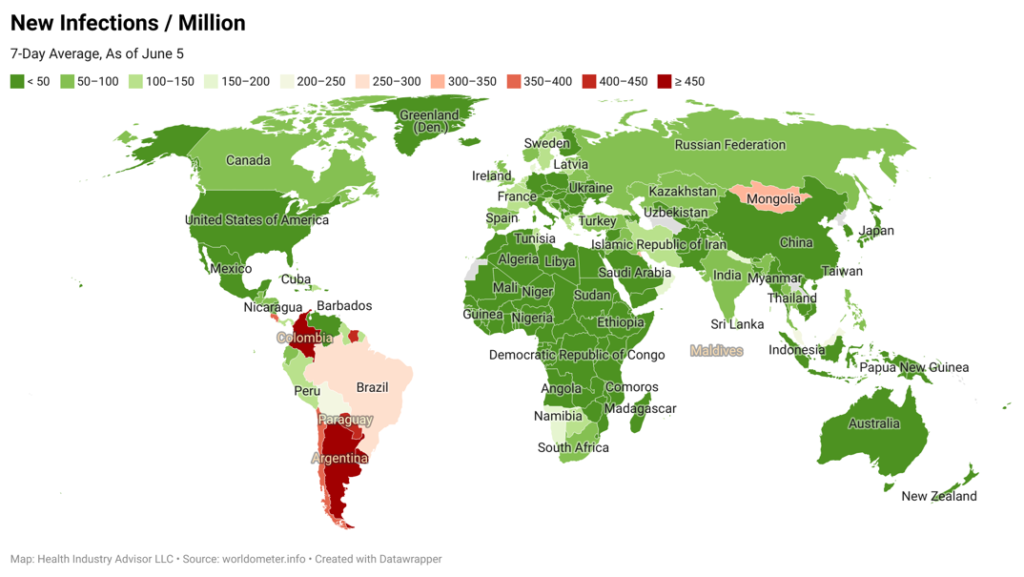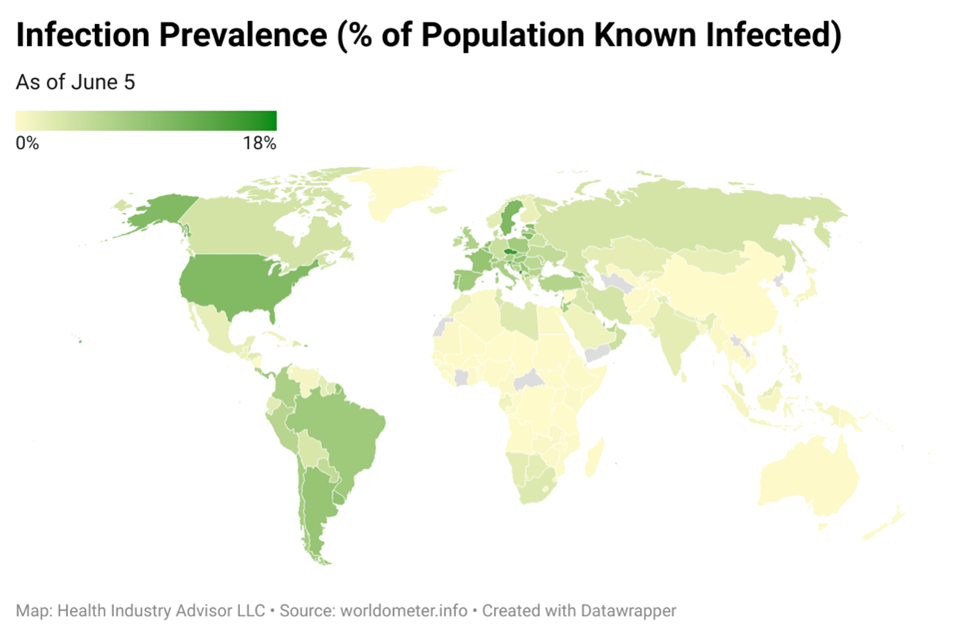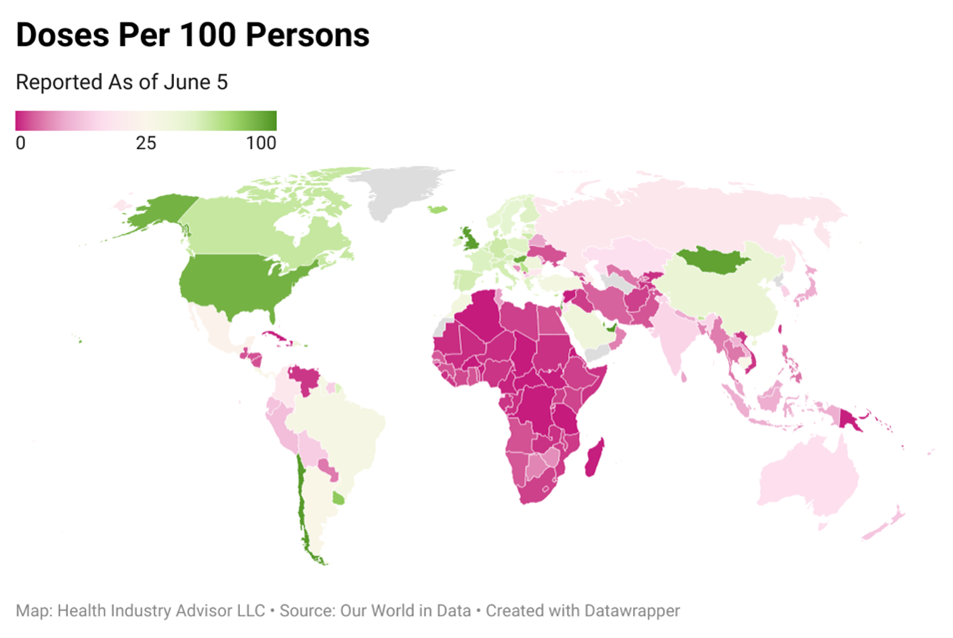June 7, 2021 – SARS-CoV-2 was declared a global pandemic in March 2020. However, the virus’s impact has not been felt uniformly across the globe. Even today, countries are facing disparate challenges in fighting the pandemic. We can map lands in three distinct stages of their pandemic experience: Firefighting, Recovery, and Containment.
Countries currently firefighting the virus are racing to get people vaccinated, often without adequate supply or infrastructure. Countries recovering from the pandemic have implemented robust vaccination processes. These countries have not eradicated the virus but should limit future spread to isolated and short-term flare-ups. Counterintuitively, those countries in the Containment stage may face the most uncertain future.
Firefighting: Covid-19 is raging throughout South America. Nearly one million new cases were detected across the continent last week alone, and 25,000 people perished. New cases increased 4% week-over-week, including 21% in Colombia and 12% in Suriname.
Of the 16 countries suffering from the highest per capita infection rates recently, 10 are South American.

Since the pandemic began, South American countries have reported 30 million cases and 900,000 deaths. Tragically, Peru has recorded the highest per capita death rate in the world.
Except for Uruguay and Chile, most South American countries have been slow in administering vaccines. This delay does not bode well to stop the spread of the virus or arrest the introduction of new variants.
Recovery: Much of Europe and parts of North America have progressed to a Recovery stage of the pandemic.
Two factors appear to be contributing to the Recovery in these countries: infection prevalence and vaccination progress. Infection prevalence provides a measure of protection, termed natural immunity. Vaccinations have proven to provide robust, lasting immunity. Public health officials have noted a trigger point: within two weeks of vaccinating at least 50% of the population, countries typically see prolonged declines in infections. Countries across Europe and North America experienced infection spikes once or several times during the pandemic. Consequently, ten European and three North American countries have posted infection prevalence rates of more than 10% of their population. Only two countries outside these continents have posted such high infection prevalence.

The United States is a bellwether of the recovery. The country has relatively high natural immunity, with infection prevalence above 10%, and high vaccination rates.
New cases plunged 35% week-over-week in the United States, extending a downward trend that began in earnest early in January. Fewer cases are being detected on average than any time since late March 2020. Estimated actual infections – accounting for untested and undetected cases – had fallen to the lowest level since five days before Covid-19 was declared a national emergency (early March 2020).
Deaths fell 28% week-over-week. Fewer people perished last week from Covid in the United States than on every day between January 1 and February 12.
Driving this improvement is a robust vaccination program. As of the weekend, the United States had administered 300 million doses. This vaccination rate places the country fourteenth in the world on a per capita basis. Sixty-four percent of U.S. adults have received at least one jab; Eighty-five percent of senior citizens have been jabbed.
However, vaccinations have slowed recently. Fewer than one million people received a dose on average each day last week. In April, this rate peaked at over three million per day. This slowdown leaves a sizable portion of younger adults (ages 18-64) unvaccinated and at risk of infection.
Thus, the United States has not eradicated the virus and may see occasional, isolated flare-ups later this Summer or Fall. We only need to look to the United Kingdom’s recent experience to observe this possibility. The U.K. had been quicker to implement its vaccination program than the United States. That country benefited from the protection afforded by its vaccination program, experiencing a sharp falloff in infections well ahead of the United States.
However, the U.K. failed to vaccinate all its citizens, leaving vulnerable concentrations in particular localities and younger residents. This vulnerability has allowed the virus to flare up, with infection rates rising for three weeks. Nonetheless, the current infection rate remains well below the levels experienced during earlier surges. High vaccination rates should cap the infection rate at a relatively low level.

Containment: Several countries, especially in Africa, Asia, and Oceania, have kept the virus in control throughout the pandemic. Through strict border closings and mitigation measures, infection rates have remained consistently low. Only Bahrain and Maldives have exceeded 10% infection prevalence. Most countries have kept this rate under 5%, including Australia (0.1%), Egypt (0.3%), Ethiopia (0.2%), Taiwan (0.04%), Hong Kong (0.16%), Japan (0.6%), New Zealand (0.5%), Nigeria (0.08%), Singapore (1.0%) and South Africa (2.8%).
That’s the good news.
However, vaccination rates have remained stubbornly low across Africa, Asia, and Oceania. Fewer doses per capita have been administered in Africa (2.3 per 100 people), Asia (22.3), and Oceania (12.3) than the worldwide average (24.5). By comparison, Europe has administered 47.7 doses per 100 and North America, 60.7.
Consequently, African, Asian, and Oceanic countries lack both natural and vaccine immunity.
Are these countries a victim of their success? With an unprotected populace, is there an exit strategy from their long-standing, strict mitigation measures? Or will they be faced with long-term isolation until the time comes that the virus is erased from the planet?
Efforts are underway to accelerate vaccine availability in Africa in particular. Asia and Oceania should presumably have the infrastructure to drive a robust vaccine program. Is the challenge there more due to vaccine hesitancy? Or is the low infection rate leaving people feeling less vulnerable?
Contributing writer:
Mark A. Van Sumeren, strategic advisor, Medical Devices & Integrated Delivery Networks
Health Industry Advisor LLC, provides a regular report on COVID-19 numbers for the health care industry.
For more information, or to sign up for the report, contact Mark at Mark.VanSumeren@HealthIndustryAdvisor.com; or visit www.HealthIndustryAdvisor.com.
